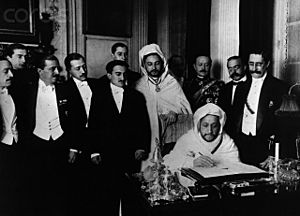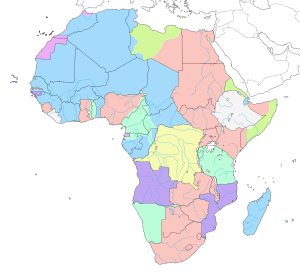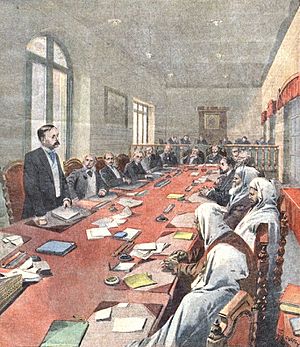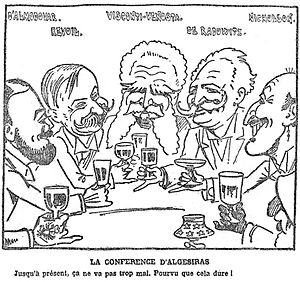Algeciras Conference facts for kids
| To ratify European intervention in Morocco following the First Moroccan Crisis | |
|---|---|

El-Hadj el-Mokri, Moroccan Ambassador to Spain, signs the treaty at the Algeciras Conference 7 April, 1906.
|
|
| Signed | 7 April 1906 |
| Location | Algeciras, Spain |
| Sealed | 18 June 1906 |
| Signatories | |
| Languages | French, English and Spanish |
The Algeciras Conference was an important meeting held in Algeciras, Spain. It took place from January 16 to April 7, 1906. The main goal was to solve a big problem between France and Germany. This problem was called the First Moroccan Crisis.
The crisis started because France wanted to take more control over Morocco. Morocco was an independent country at the time. Germany didn't want France to become too powerful. Germany hoped to gain more respect and influence on the world stage.
However, Germany's plan didn't work out. Instead, the conference made France and Britain much closer. Their friendship, called the Entente Cordiale, became stronger. Both countries started to trust Germany less. This event also made many people in Germany feel angry and ready for war.
Contents
Why the Conference Happened

In 1904, Britain and France made an agreement called the Entente Cordiale. This agreement helped them work together. It said that Britain could have more control in Egypt. It also said France could have more control in Morocco. Some parts of Morocco were also given to Spain.
Germany saw this agreement and worried. They thought it would make Britain and France too strong together. Germany felt like it was being left out of important European decisions.
On March 31, 1905, Germany's leader, Kaiser Wilhelm II, visited Tangier in Morocco. He gave a strong speech. He demanded an international meeting to make sure Morocco stayed independent. He even suggested war if his demands were not met. Historians believe Germany used strong words to show other countries that they needed to talk to Germany about world issues. France had not discussed its plans for Morocco with Germany, which made Germany upset.
German diplomats hoped to get the US President, Theodore Roosevelt, to support them. Roosevelt was busy trying to end the Russo-Japanese War. He also knew the US didn't want to get involved in European problems.
But by June 1905, the situation got worse. It looked like Germany and France might go to war. Britain might even join in. So, in July, President Roosevelt convinced France to attend a peace conference. This meeting was set for January in Algeciras.
Germany hoped the conference would weaken the Entente Cordiale. Kaiser Wilhelm II thought he could even make an alliance with France. He also believed he could improve relations with Russia. Russia was weak after a revolution and a war.
However, Germany was mostly left out of the early decisions. Britain's Foreign Secretary, Sir Edward Grey, showed strong support for France. He met often with the French Ambassador. This made the Entente Cordiale even stronger, not weaker.
After failing to isolate Britain, Germany started to build up its navy even more. This led to a naval arms race between Britain and Germany. The conference helped create a divide between Germany and its allies (the Triple Alliance) and Britain, France, and Russia (who later formed the Triple Entente).
Morocco's Challenges at the Conference
Sultan Abdelaziz of Morocco sent two representatives: Muhammad al-Muqri and Muhammad Torres. They faced many problems during the conference. One big issue was language. Al-Muqri said, "We're sitting here like statues; we can't understand a thing of what is said."
The Moroccan team had to use Abdelqader Benghabrit as a translator. He was an Algerian who worked for France. This made it hard for the Moroccans to speak freely.
Another problem was contacting their Sultan. The Moroccan representatives needed to tell the Sultan everything. They also needed his approval for every decision. But Fes, where the Sultan lived, had no telephone or telegraph. There were no good roads or trains either. This made it very difficult to get messages to him quickly.
What Happened Next
The final agreement of the conference was signed on April 7, 1906. It covered several important points for Morocco:
- Police and Customs: How Morocco's police and customs would be organized.
- Smuggling: Rules to stop weapons from being smuggled.
- Banking: A new State Bank of Morocco was created. This bank would issue banknotes backed by gold. It would last for 40 years. The bank would be Morocco's central bank. Its spending would be strictly controlled. Administrators from the national banks of Germany, Britain, France, and Spain would manage it. These banks had given loans to Morocco.
- Land Ownership: Europeans were given the right to own land in Morocco.
- Taxes: New taxes would be collected to pay for public works projects.
The Sultan of Morocco kept control of the police force in six port cities. This force would be made up only of Moroccan Muslims. French and Spanish officers would train them. These officers would also oversee their pay and discipline. The main inspector for the police would be Swiss. He would live in Tangiers.
At the very end, the Moroccan delegates found they could not sign the final agreement right away. But on June 18, 1906, Sultan Abdelaziz of Morocco officially approved it.
Who Attended
Many countries sent representatives to the Algeciras Conference. Here are some of the main attendees:
- Germany – Joseph Maria von Radowitz, Jr. and Christian, Count of Tattenbach
- Austro-Hungary – Rudolph, Count of Welsersheimb and Leopold, Count Bolesta-Koziebrodzki
- Belgium – Baron Maurice Joostens and Conrad, Count of Buisseret Steenbecque
- Spain – Don Juan Pérez-Caballero y Ferrer and Juan Manuel Sánchez, Duke of Almodóvar del Río
- United States – Henry White and Samuel R Gummere
- France – Paul Révoil and Eugène Regnault, Abdelqader Benghabrit
- United Kingdom – Arthur Nicolson, 1st Baron Carnock
- Italy – Emilio, marquis Visconti-Venosta and Giulio Malmusi
- Morocco – El Hadj Muhammad Torres and El Hadj Mohammed Ben Abdesselam El Mokri
- Netherlands – Jonkheer Hannibal Testa
- Portugal – António Maria Tovar de Lemos Pereira (Count of Tovar) and Francisco Roberto da Silva Ferrão de Carvalho Martens (Count of Martens Ferrão)
- Russian Empire – Arthur, Count Cassini and Basile de Bacheracht
- Sweden – Robert Sager
See also
 In Spanish: Conferencia de Algeciras para niños
In Spanish: Conferencia de Algeciras para niños
- International relations of the Great Powers (1814–1919)
- Entente Cordiale 1904
- First Moroccan Crisis March 1905–May 1906
- Bombardment of Casablanca (1907)
- Hafidiya
- Second Moroccan Crisis 1911
- Causes of World War I



